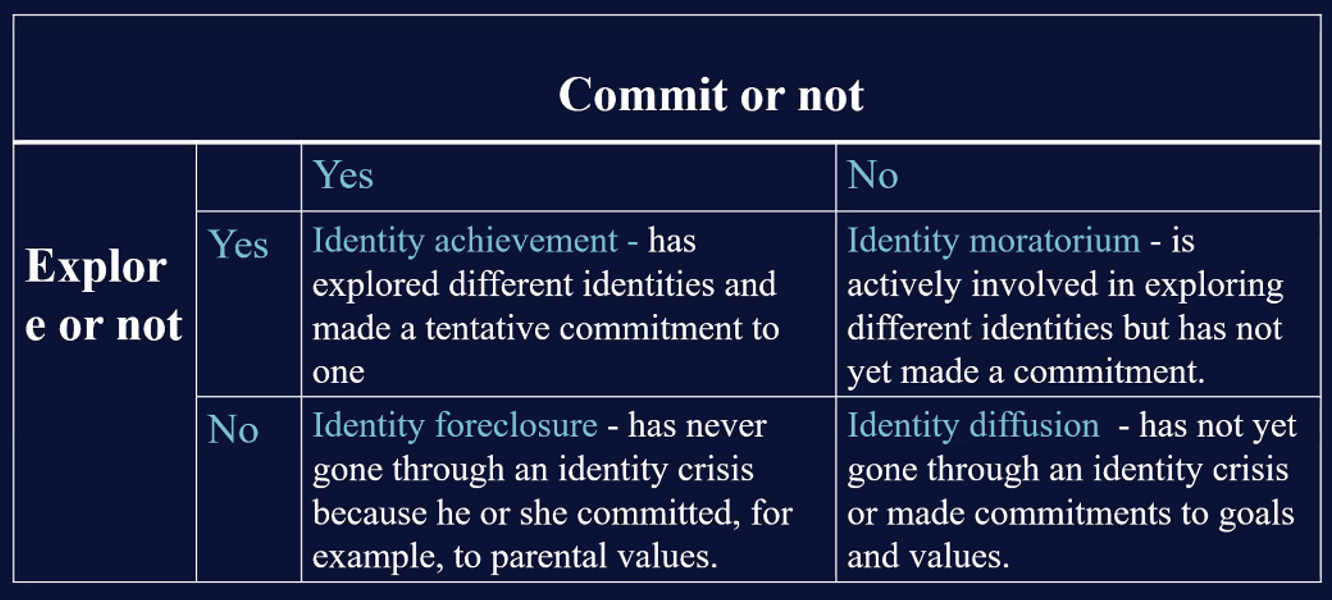Psychology and Life (Virtual Course at Fudan University)
1. Chapter 1: History and Perspectives
1.1. The goals of Psychology
The goals of the psychologist conducting basic research are to describe, explain, predict and control behavior.
- Describe: making accurate and objective observations about behavior/phenomenon
- Explain/Understand: finding consistent patterns of behaviors & mental
processes
- Predict: making statements about the likelihood of certain behavior or relationship
- Control/Influence: making certain behavior/mental processes appear or disappear.
The most important: Control and influence.
E.g., define procrastination (拖延)
- Describe: Replacing high-priority actions with tasks of low-priority. It is counterproductive, needless and delaying.
- Explain: Boring tasks. Impulsive. Perfectionism.
- Predict: People who have difficulties in delay gratification.
- Control: Try to understand the reasons for procrastination. Subgoaling. Seek professional help.
1.2. Definition of Psychology
- Psychology
- The scientific study of the behaviour and mental process of individuals.
- Scientific method: consists of a set of orderly steps used to analyze and solve problems.
- Behaviour: actions taken by organisms to adjust to their environment.
- Individual: the target of the psychological analysis.
- Mental processes: the working of the human mind, such as critical thinking, planning reasoning, creating and dreaming etc.
1.3. First Psychologists (Memorize)
Wilhelm Wundt:
- had been trained as a physiologist. his interest shifted from questions of body to questions of mind. wished to understand basic processes of sensation and perception as well as the speed of simple mental processes.
- Founded the first formal laboratory devoted to experimental psychology (1879, Leipzig, Germany)
- Firstly distinguish Psychology from Physiology
- Structuralism: Mind can be split into distinct structures.
- Method: Introspection.
Edward Titchener:
- Wundt’s student.
- One of the first psychologists in the US. Found a laboratory at Cornell University in 1892.
William James:
- The Principles of Psychology (1890): The most important psychology text ever written.
- Functionalism: Minds with a purpose. Focus on how mental processes work (not the elements) and purposes of behavior.
1.4. Contemporary Perspectives in Psychology
psychodynamic, behavioral, biological, evolution, humanistic, cognitive, social cultural.
Comparison of seven perspectives:

1.4.1. Psychodynamic
Sigmund Freud:
- The unconscious, inner forces & conflicts are the main causes underlying our behaviors.
- Tension reduction is the purpose of all behaviors.
- Freud’s ideas grew out of his work with mentally disturbed patients, but he believed that the principles he observed applied to both normal and abnormal behavior.
- human nature is not always rational and that actions may be driven by motives that are not in conscious awareness
1.4.2. Behaviorist
John B. Waston:
- Environment matters: every behavior is triggered by a stimulus
- Study of the relationship between stimulus and behavior
- Mental states cannot be studied
- Introspection 反省 is not objective 客观
- “Talk is cheap”
- Stimulus -> Black Box -> Response
B. F. Skinner
- Operant conditioning (training)
- Reinforcement (reward, stimulus) increases the incidence of a behavior
- Punishment decreases the incidence
- Verbal Behavior (1957)
- Attempt to explain how children learn to use language with operant conditioning
1.4.3. Humanistic
- the third wave, challenging the first two waves: people are neither driven by the powerful, instinctive forces, nor manipulated by their environments.
- Instead, people are active creatures who are innately good and capable of choice.
- men strive to seek positive self development and are capable of making meaningful choices.
Abraham Maslow (1908- 1970)
- Multiple-motivation-system: Hierarchy of needs
1.4.4. Cognitive revolution
Focus on mental processes (attention, thinking, problem solving, decision making etc.)
Noam Chomsky (1928 -)
- Critique of Skinner’s Verbal Behavior:
- Humans are genetically predisposed to learning language
- Language requires some kind of mental representation
- used a series of mental tasks to demonstrate qualitative changes over the course of cognitive development
George Miller: Why can people remember 7 (+ or - 2) items, but not more?
1.4.5. Biological
- Experience and behaviors are largely understood as the result of chemical and electrical activities taking place within and between nerve cells.
- Reductionism: even the most complex behavior can be entirely explained by chemical and electrical activities
- “What changes in your brain occurred while you learned to read?”
- Behavioral neuroscience: to understand the brain processes underlying behaviors such as sensation, learning, and emotion.
- Cognitive neuroscience: focus on the brain bases of higher cognitive functions such as memory and language
1.4.6. Evolutionary
- Darwin: law of natural selection
- Those organisms that are better suited to their environments tend to produce offspring (and pass on their genes) more successfully than those organisms with poorer adaptations
- Metal abilities & behavioral tendencies are evolved to solve central adaptive problems (survival pressures): eating, mating, keeping safe
1.4.7. Social-cultural
- Social and cultural factors (other than physical environment) shape our behaviors and mental processes, e.g. religious belief
- Human beings are essentially social beings (instead of physical beings) and need to survive socially
- A cross-cultural perspective can be brought to bear on almost every topic of psychological research:
Do the languages people speak affect the way they experience the world?
How does culture affect the way children develop toward adulthood?
How do cultural attitudes shape the experience of old age?
1.5. Subfields of Psychology
- Biological psychologists exploring the links between brain and mind
- Developmental Ps studying our changing abilities from womb to tomb
- Cognitive Ps experimenting with how we receive, think, and solve problems
- Personality ps investigating our persistent traits
- Social ps exploring how we view and affect one another.
- Industrial/organizational Psychologists
- Counseling Ps - to cope with challenges and crises
- Clinical Ps - assess and treat mental, emotional, and behavior disorders
- Psychiatrist, MD, licensed to prescribe drugs and otherwise treat physical cause of psychological disorders.
2. Chapter 2: Biological Basics
Today’s Outline • The show of the biological/evolutionary perspective: different level of analysis and explanation of Cause-and-effect • The biological bases: the nervous system and the brain What part of & how the nervous system and brain make it possible to produce (what type of) psychological functions? • The evolutionary bases: heredity and behavior What & why psychological processes evolve and for what functions?
2.1. Neuron
Neuron
- The basic unit of the nervous system
- There are between 100 billion and 1 trillion neurons in your brain. Our brain contains more cells than there are stars in our entire galaxy
- Basic functions: to receive, process, and /or transmit information to other cells within the body.
- Structure:
- Soma: the cell body
- Dendrites: the branched fibers that receive incoming signal from other neurons.
- Axon: a single extended fiber that transmit information to terminal buttons.
- Terminal buttons: bulblike structures at the other end of axon, able to stimulate nearby glands, muscles, or other neurons.
Mirror Neuron:
- They are activated whether we make an action ourselves or when we see others do the same
- Enable us to understand the intentions of other people’s behavior.
- Learn through imitation
- Use your own experiences to make sense of other people’s behavior
2.2. Brain
- Three layers:
- Brain stem - maintain autonomic processes, such as breathing
- Thalamus 丘脑 - passing sensory information to cortex 脑皮层
- Cerebellum 小脑 -body movement, procedure memory acquisition
- Limbic system - emotional center, motivation, emotional memory
- Hippocampus 海马回 acquisition of long-term memories
- Amygdala 杏仁核 detect & evaluate threats; formation of emotional memory
- Hypothalamus 下丘脑 motivation regulation & maintain internal balance
- Cerebrum - the headquarter of “human civilization”
- Main composition: cerebral cortex (2 hemispheres) + corpus callosum 胼胝体
- Four brain lobes
- Frontal lobe 额叶 - motor control and cognitive activities
- Parietal lobe 顶叶 - sensation of touch, pain, and temperature
- Temporal lobe 颞叶 - processes of hearing
- Occipital lobe 枕叶 - final destination for visual information
- Brain stem - maintain autonomic processes, such as breathing
Broca’s area: related to speech.
Left hemisphere: control the most ability to produce speech (no matter left-handed or right-handed).
2.2.1. Methods to explore the brain
- Lesion study
- EEG
- Brain Imaging
Event related potentials (ERP)
- Uses electroencephalogram (EEG) recording to detect electrical activity of brain
- Mechanism: Neurons firing cause slight changes in the electrical potential of the scalp
- A single EEG recording of an experimental trial has a lot of noise, but if you sum over a great number of trials, the noise averages out and you can see systematic patterns
- Advantages:
- High temporal resolution - you can distinguish different stages of processing
- Relatively cheap
- Disadvantage:
- Low spatial resolution - hard to tell where the activation comes from
Brain Imaging:
- Uses Magnetic Resonance Imaging (MRI) and Functional MRI (fMRI) to detect changes in the flow of blood to cells in the brain
- MRI gives us very high-resolution, three-dimensional images of the body (structural MRI)
- Mechanism:
- Brain reacts to neuronal activity by increasing blood flow to the active areas. Higher oxygen saturation in active areas
- MRI can distinguish oxygen-rich blood from blood that is low in oxygen.
- Mechanism:
- Advantages
- Relatively high spatial resolution: Which part of the brain is activated.
- No radioactivity
- More and more widely available
- Disadvantages
- Poor temporal resolution - brain takes ~ 1-2 s to adjust the blood flow
- Still expensive - around $60/h
2.2.2. Plasticity
- Changes in the performance of the brain based on experiences
- Self healing: collateral sprouting 侧枝出芽; substitution of function and neurogenesis
2.3. Evolution and Natural Selection
Evolutionary Psychology:
- Foundational theory for evolutionary approach in psychology: Darwin’s theory, the concept of psychological adaptation.
- Goal: (Confer et.al., 2010): “to study human behavior as the product of evolved psychological mechanisms that depend on internal and environmental input for their development, activation, and expression in manifest behavior”
- More specific evolutionary theories (e.g. inclusive fitness theory, W.D. Hamilton) are created to provide explanation to critical issues other than survival, such as matin, parenting, altruistic behaviors, aggression and so on.
- Genotypes 基因型
- genetic structure (from parents)
- determines an individual’s development and behaviors within a particular environment.
- Phenotypes 表型
- outward appearance and repertory of behaviors
- Epigenetics 表冠遗传学
- Genes are not destiny; environment may enhance or inhibit the expression of certain genes
- Heritability 可遗传性
- an estimate of the contribution of inheritance to a given trait or function in a group sample. Its value ranges from 0 to 1. E.g., intelligence ? %, height ? %
- Measuring heritability:
- We need to control one influence andmanipulate the other
- Twin studies
- To assess how much more alike monozygotic (MZ, identical) twins are than dizygotic (DZ, fraternal) twins on a certain attributes
- Similarity in gene between MZs vs. DZs: 100% vs. 50%.
- Equal environment hypotheses and representative hypotheses
- Adoption studies: To access the relative similarity between adopted children to their birth parents and to their adopting parents.
- Measuring heritability:
3. Chapter 3: Scientific Methods
3.1. Key Concepts in Psychological Science
- Scientific Methods
- A general set of procedures for gathering information and interpreting evidence to acquire knowledge.
- Minimize sources of errors & yield dependable conclusions.
- However, scientific methods can not solve every problem in our lives.
- Rather, as S. Pinker points out: “To transfer myth into questions”
- Theory (not truth)
- An organized set of concepts that (temporarily) explains a set of phenomena (based on prior scientific evidence)
- Determinism (the underlying philosophical basis): to discover causal factors and lawful patterns (between behavior and mental processes)
- Testable or falsifiability (Hypothesis)
- “the best that can be said about a theory or prediction is that it is not yet falsified”
- Think about the psychodynamic perspective.
- Hypothesis
- A tentative & testable statement about the relationship between causes and consequences/effects
- Hypothesis testing is the central theme in most modern psychology research.
- Operational definition
- A definition of a concept in terms of specific operations (procedures, actions) used to measure it or to determine its presence.
- All the variables in an experiment must be given operational definitions.
E.g.,
“fear” might be operationally defined as specified changes in heart rate, galvanic skin response, pupil dilation, and blood pressure.
- The type of definition that contrasts with ’operational definition’ is referred to as ’conceptual definition’.
- Variable
- any factor that varies in amount or kind
- Independent variable (IV): the factors the experimenter manipulated & it functions as pthe causal part
- Dependent variable (DV): the experimenter measures & it is the effect part the cause effect.
3.2. Experimental Methods
- Method: Researchers manipulate an independent varialble to looke for an effect on a dependent variable.
- Goal: to make strong causal claims about the impact of one variable on the other.
- Confounding variable
- not IV, not DV, but add confusion to the interpretation of the data.
- Expectancy effects: expected effects that caused by a researcher or observer’s subtly communicating to participants the kind of behavior he or she expects to find.
- Placebo effects - effects that occur in the absence of an experimental manipulation.
Control procedures
- Double blind control
- Control group
- Between-subject design
- Each participants is randomly assigned to only one condition and is compared to another group that is exposed to a different condition.
- Random assignment
- Random sampling - every member of a population has an equal likelihood of participating in the experiment.
- Population: the entire set of individuals to which generalizations will t made based on an experimental sample
- Sample: A subset of a population selected as participants in an experiment
- Within-subject design
- Each participant experiences all conditions and is tested repeatedly for differences between them.
3.3. Correlational methods
- Correlation coefficient: the degree of correlation between \([-1, 1]\).
- Limitation: Correlation does not necessary imply causation.
Psychological measurement
- procedure for assigning numbers or categories to a variable
- Reliability: the consistency or dependability of behavioral data
- Validity: the degree of accuracy of the measurement
- Different forms: self-report (survey, interview), observation, using archival data and so on
3.4. Other methods
Computer Metaphor: Computers can read and store information, transform it using set algorithms (programs) and output
4. Chapter 4: Sensation and Perception
4.1. Sensation
- Sensation
the process where the stimulation of sensory receptors produces neural impulses that represent internal or external experiences
- Stimulus: anything that can be detected by the sensory organs, e.g. the light wave, the chemical in a perfume
- Sensory receptors: specialized cells in different sensory organs
- Transduction
- the conversion of one form of physical energy to another form, i.e. neural impulses
Process:
- Stimulus e.g. light waves
- Sensory receptors sensory organs
- Transduction physical energy to neural impulses
- Discrete neural pathways involving multiple brain
Classic five senses:
- vision: rod and cone cells.
- hearing
- smell
- taste
- touch: free nerve ending, meissner
4.1.1. Psychophysics
Fechner (1801 - 1887)
- The study of the relationship between physical stimuli and psychological experience (sensation).
- Absolute Threshold
- The minimum amount of physical energy needed to produce a sensory experience.
- Operational definition: the stimulus level at which a sensory signal is detected half the time.
- Difference Threshold
- The smallest physical difference (just noticeable difference, JND) between two stimuli that can still be recognized as a difference.
- OD: the point at which the stimuli are recognized as different half of the time
- Weber’s law
- JND between stimuli is a constant fraction of the intensity of the standard stimulus
- the bigger or more intense the standard stimulus, the larger the increment needed to get a just noticeable difference.
- 100g vs 110g & 1000g vs 1010g?
Sensory Adaptation
- e.g., sunshine seems less blinding after a while outdoors; foul odor fades out as your smell system adapts.
- The diminishing responsiveness of sensory systems to prolonged stimulus input
4.1.2. The Visual System
Sensory organ: eye
- The journey:
- light-cornea 角膜
- anterior chamber 房水
- pupil (iris 虹膜)
- retina-receptors (being sensitive to photons with specific wavelength
- optic nerve-lateral geniculate nucleus of the thalamus (LGN,丘脑视神经外侧膝状核)
- primary visual cortex (occipital lobe)-secondary visual cortex
The Retina
- Convert info. about the world from light waves into neural signals.
- Rod cells: 120 millions, Operates best in near darkness
- Cone cells: 6-7 millions. Densely packed in fovea, specialized ine bright, color-filled in Tiled,
- Blind spot/optic disk where the optic nerve leaves the eye and no receptors
Eye Adaptation:
- Human eyes have extraordinary abilities to adjust to different levels of light and ndarkness
- From daylight to darkness: 20-30 minutes
- From darkness to daylight: 5 minutes
- Dark Adaptation
- The gradual improvement of the eyes’ sensitivity after a shift in illumination from light to near darkness
- Rods are able to respond to less light from the environment than your cones are
| Physical properties | Experience of color |
|---|---|
| wavelength | hue |
| intensity (wave’s amplitude) | brightness |
| purity | saturation |
4.2. Perception
- Perception
- the process where neural impulses are organized and transformed into mental representations (storage & transference) and recognized as meaningful objects (transference & output)
- Attention: enable you to direct your awareness to a subsets of all the information available to you
- Goal directed attention vs. stimulus-driven attention
- You make the choice about where you direct your attention
- The features of the stimuli automatically capture your attention
- Novel stimulus in the environment
- Cocktail party effect
- Attentional bias: e.g. specific negative attentional bias in social anxiety
4.2.1. Principles of Perceptual Grouping
- Gestalt laws
- Form perception
- Figure and ground
- Proximity
- Similarity
- Good continuation
- Closure
4.2.2. Depth Perception
How to perceive 3-dimentional world out of 2- dimentional patterns ?
Binocular cues: comparisons of the visual information from two eyes
- Retinal disparity: (the displacement between the horizontal positions of corresponding images in the two eyes) increases with the distance in depth between two objects
- Convergence: ( the degree to which the eyes turn inward to fixate on an object), increases as the objects gets closer (within 1 meter)
Monocular cues:
- Interposition: occluded object is farther away than the occluding one.
- Relative size: Objects of the same size at different distances project images of different sizes on the retina.
- Linear perspecive: parallel lines seem to converge at distance.
- Texture gradient: a texture is coarser for near areas and finer for more distant ones.
- Perceptual constancy: you see the world as invariant, constant, and stable
despite changes in the stimulation of your sensory receptors.
- Size constancy: refers to your ability to perceive the true size of an object despite variations in the size of its retinal image.
- Shape constancy: You perceive an object’s actual shape correctly even when the object is slanted away from you, making the shape of the retinal image substantially different from that of the object itself.
- Lightness constancy: is your tendency to perceive the whiteness, grayness, or blackness of objects as constant across changing levels of illumination.
4.2.3. Meaning Seeking
Bottom-up process
- Taking sensory data in and sending it to the brain for extraction and analysis
- Data-driven processing: the starting point is the sensory data
Top-down process
- The process where your expectations affect perception
- Conceptually-driven processing: concepts in memory affect the interpretation
The influence of contexts, expectations &experiences
- Perceptual set: A readiness to detect a particular stimulus in a given context (a mental predisposition to perceive one thing and not another )
5. Chapter 6: Learning
5.1. Consciousness or Behavior
A change of perspective & paradigm: Consciousness vs. behavior
- Subjective vs. objective and measurable
- Introspection vs. behavior analysis
- Internal motivation vs. external stimulus
- Human vs. animal
John Watson & behaviorism
- The goal is to predict and control behavior
B. F. Skinner & radical behaviorism
- Mental activities are not “causes” of behaviors but are “caused” by external stimulus
- Search for principles of learning-S-R-C: how environmental stimulus determines learning and behavior
5.2. Definition of Learning
- Learning
- A process (based on experience) that results in a relatively consistent change in behaviors or behavior potential
- learning \(\neq \) performance
- Consistent change
- Acquisition vs. instinct
- Maturational readiness sets the stage for learning
5.3. Three Forms of Learning
5.3.1. Classical Conditioning
An accidental discovery by Pavlov.
Pavlov:
- A Russian physiologist, who won the Nobel Prize on medicine for his work on the gastric juices involved in digestion
- “Accidents” of measuring secretions: from meat powder iptself to other stimulus (“predicting” the meat powder)
- A turning point for his career: 532 studies in 30 years
- Classical conditioning
- a type of learning in which an initially neutral stimulus (NS), when paired with a stimulus that elicits a reflex response, results in a learned response.
- Reflex: response triggered by specific stimuli that are biologically relevant for the organism
- Components:
- Unconditioned Stimulus (UCS)
- the specific stimulus that triggers the reflex.
- Conditioned Stimulus (CS)
- a neural stimulus that is intended to pair with the UCS to trigger the reflex.
- Unconditioned Response (UCR)
- the response triggered by UCS.
- Conditioned Response (CR)
- the (same) response triggered by CR.
- Procedures:
- Before conditioning: UCS automatically elicits UCR. CS (neural) elicits no or irrelevant response.
- During conditioning: CS followed by UCS elicits UCR.
- After conditioning: CS directly elicits CR.
Other types of conditioning
- Delay conditioning (most widely used and most effective): the CS comes prior to and stays on at least until the UCS is presented.
- Trace conditioning: the CS is discontinued or turned off before the UCS is presented.
- Simultaneous conditioning: both the CS and UCS are presented at the same time.
- Backward conditioning: the CS is presented after the UCS
Timing Requirements:
- CS and UCS must occur close together in time.
- CS must also reliably predict and occurrence of the UCS.
- Extinction
- CR no longer appears when CS is presented due to the fact that CS does not predict UCS
- Spontaneous 自发的 recovery
- CS elicits a weak CR after extinction
- Rapid relearning of CS-CR (saving)
- Stimulus Generalization
- Once a CR has been conditioned to a particular CS, similar stimuli may also elicit the response. The more similar the new stimulus is to the original CS, the stronger the response will be.
- Stimulus Discrimination
- Respond differently to stimuli that are distinct from the CS on some dimension (e.g., differences in hue or in pitch).
Implications and Applications
- Fear conditioning: Watson and Little Albert
- UCS (loud noise), UCR (startle response)
- NS (white rat) -> UCS (7 times) -> CS
- Generalization: white rat -> other furry objects
- Advertisement and positive emotional conditioning
- UCS (beautiful woman) -> UCR (sexual arousal)
- NS (product, such as a type of whisky) + UCS -> CS
5.3.2. Operant Conditioning
Operant conditioning: Learning about consequences
- Law of effect (E L. Thorndike, 1874 - 1949) A response that is followed by satisfying consequences becomes more probable and a response that is followed by dissatisfying consequences becomes less probable.
- B. F. Skinner embraced Thorndike’s view that environmental consequences exert a powerful effect on
- Operant
- the behaviors exhibited by an organism that have observable effects on its environment
- Operant conditioning
- A type of learning where the frequency of a behavior (operant) is influenced by its consequences (resulting environmental stimuli).
Reinforcement Contingencies 偶发事件 (RC)
- Establish the RC
- A consistent relationship between a response and the changes in the environment.
- Reinforcer
- a stimulus that increases the probability of a given behavior
Reinforcement: the delivery of reinforcers
- Positive Reinforcement
- A process of increasing the likelihood of a behavior by following it with the delivery of a pleasant stimulus.
- Negative Reinforcement
- A process of increasing the likelihood of a behavior by following it with the removal of an aversive stimulus.
- Positive punishment
- A process of reducing the likelihood of a behavior by following it with the delivery of an aversive stimulus.
- Negative punishment
- A process of reducing the likelihood of a behavior by following it with the removal of a pleasant stimulus.
The disadvantage of using punishment:
- Reinforcing the abuser, Lead to other “unwelcomed” response, e.g., avoidance & aggression
How to use punishment effectively:
- “Follow through” the rule, Limited time and intensity, Reinforcing the appropriate behavior at the same time
- Try to use negative punishment instead of positive punishment.
- Do not punish someone because of the person’s personality / characteristics.
Types of Reinforcers
- Primary reinforcers
- (biologically determined, e.g. food, sex)
- Conditioned reinforcers
- (NS associated with PR, e.g. money, praise)
Criterion for choosing effective reinforcers: things or activities that one prefers or is derived - one man’s trash is another man’s treasure
5.3.3. Reinforcement Schedules
- Continuous reinforcement
- Every time a behavior occurs, it is followed by a reinforcer (reward) without exception. This schedule is useful for initially establishing a behavior.
- Partial reinforcement
- Not every occurrence of the behavior is reinforced. It can be more “extinction-resistant”.
- Fixed-Ratio
- Reinforcement is delivered after the organism has emitted a fixed number of responses. For example, a unit-payment system where an employee receives payment for every fixed number of units produced.
- Variable-Ratio
- reinforcement is given after an unpredictable (variable) number of responses are made by the organism. E.g., gambling; highest rate of R and greatest resistance to extinction
- Fixed-interval
- Reinforcement is delivered after a fixed period of time has passed since the last reinforcement was given. A scalloped pattern (扇形模式)
- Variable-Interval
- a response is rewarded after an unpredictable amount of time has passed. A moderate & stable pattern.
- Application
Shaping: To train new or complex behaviors, you will want to use a method called shaping by successive approximations in which you reinforce any responses that successively approximate and ultimately match the desired response.
5.3.4. Cognitive Influences on Learning
Nature vs. Nurture: the limits of behaviorism
- Biological factors may put “limits” on classical conditioning and operant conditioning.
- Instinct drift: learned behavior drifts toward instinctual behavior
- e.g. pigs poked at coins with snout instead of putting them into a “piggy bank”
- “Genetically programmed resistance to change”
- Observational learning (social learning or modeling)
- method of learning that consists of observing and modeling another individual’s behavior, attitudes, or emotional expressions.
- Vicarious reinforcement and punishment
- Expectation matters.
Albert Bandura, Stanford University.
- Can violent behaviors be learned by observation?
- Four-processes theory
- attention
- retention
- motor reproduction
- motivation
6. Chapter 7: Memory
- Memory
- Memory is the capacity to encode, store, and retrive information.
- Encoding: the initial processing of information & forming mental representations of information.
- Storage: the retention over time of encoded material.
- Retrieval: the recovery at a later time of the stored information.
- Implicit memory
- without conscious effort.
- Explicit memory
- engage conscious effort.
Three-stages model of memory:
- Information is stored in three independent (functionally) yet connected memory systems (not places).
- Sensory memory (SM) -> Working memory (including short-term memory) (STM) -> Long-term memory (LTM).
- SM duration: iconic information < 0.3s, ethoic information < 2s
- STM duration: < 15s
- LTM duration: \(\infty\).
6.1. Sensory Memory
Sensory memory:
- Iconic 图像 and echoic 回声 memory
- Each sensory experience is stored briefly until it is further processed.
- Fades rapidly: 1/4 to 1/2 second
- Capacity: huge.
6.1.1. Measuring the Capacity of Iconic Memeory
By G. Sperling (1960)
- Whole-report procedure
- Materials: 3x4 matrix of letters and numbers.
- Display time: 1/20 second (50ms), very short.
- Task: To report as many as possible
- Result: participants only reported 4 items.
- Partial-report procedure
- Materials: the same.
- Display time: the same.
- Task: To report only one row according to the tone signal.
- Result: Most participants could remember correctly for any of three rows.
- Inference: All of the information in the display has gotten into iconic memory. (large capacity).
Fading speed:
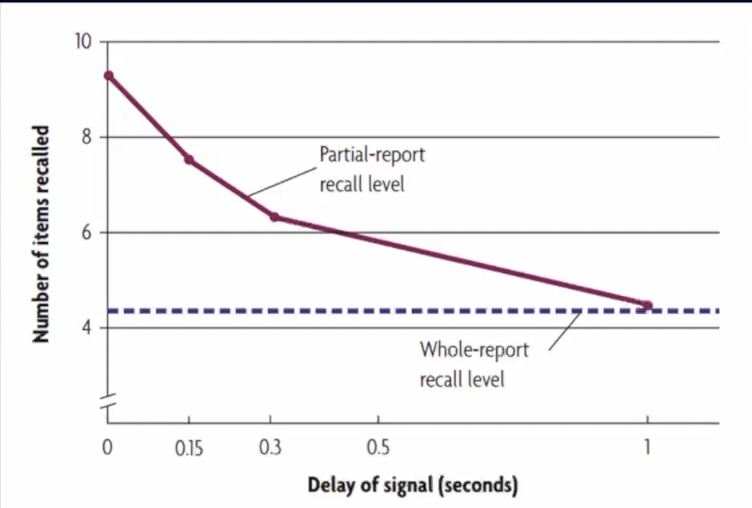
6.2. Short-term Memory (STM)
- Short-term memory
- Sensory information you choose to focus your attention on will be processed further in STM.
- E.g., look for a phone number
Test for STM: G. Miller, 1956
- Free recall: Learn the shown information and try to memory. Report later whather in your mind (no specific form / order)
- Digital span test: Show digits for a short period. Record the span of the maximum length of digits you can still remember.
Improving the capacity of STM:
- Rehearsal:
- repeat the information.
- info gets lost in 18 seconds unless you rehearse it.
- Chunking:
- A chunk could be a piece of meaningful / intuitive information.
- Chunking: the process of reconfiguring items by grouping them into chunks.
- An updated model of STM
- A. Baddeley
- Moment-by-moment memory resource used to accomplish mental tasks: more than just store the information
- WM can be thought as the active part of STM.
Test for WM:
- Operation span test:
- Materials: A pair of question and word diaplayed at the same time.
- The question, e.g., a simple arithmatic problem, keeps your brain active.
- Task: Answer the question on and meanwhile remember the word. Report the words after going through several pairs.
6.3. Long-Term Memory (LTM)
- LTM
- The storehouse of all information acquired by SM and STM, constituting each person’s total knowledge of the world and of the self.
- Process, SM to STM vs. STM to LTM:
- Coding: relies more on meaning rather than sounds.
- Retrieval: searching vs. using retrieval cues.
- Forgetting: fading vs. retrieval failure
- Biological basis: prefrontal / parietal / occipital cortex vs. hippocampus and cortex for language processing and perception.
- Process, SM to STM vs. STM to LTM:
Retrieval cues: the stimuli available as you search for a particular memory.
- external
- internal (generally): the past experience.
Recall and recognition:
- Recall
- Reproduce previously exposed information. Few cues. Open-question format.
- Recognition
- realization that certain information was seen or heard by you. More cues. Multiple-choice test format.
Components:
- Declarative memory
- the recollection of facts and events
- Semantic memory: generic, categorical memories, such as the meanings of words and concepts.
- Episodic memory: specific personal events and experiences.
- Procedural memory
- the way how things get done
6.3.1. Contex and encoding
The principle of encoding specificity: Memories emerge most efficiently when the context of retrieval matches the context of encoding.
Context-dependent memory (Godden & Baddeley, 1975):
- Scuba divers learned lists of words either on a beach or under water.
- Tested for retention of those words in the two contexts.
- Perforance was nearly 50% better when the context at encoding and recall stage matched.
7. Chapter 8: Cognitive Processes - Language
7.1. Cognition
- Cognition
- A general term for all forms of knowing, including contents and processes (mental processing).
- Cognitive contents are what you know: concepts, facts, propositions, rules, and memories.
- Cognitive processes are how you manipulate these mental contents in ways that enable you to interpret the world around you and to find creatives solutions to your life’s dilemmas.
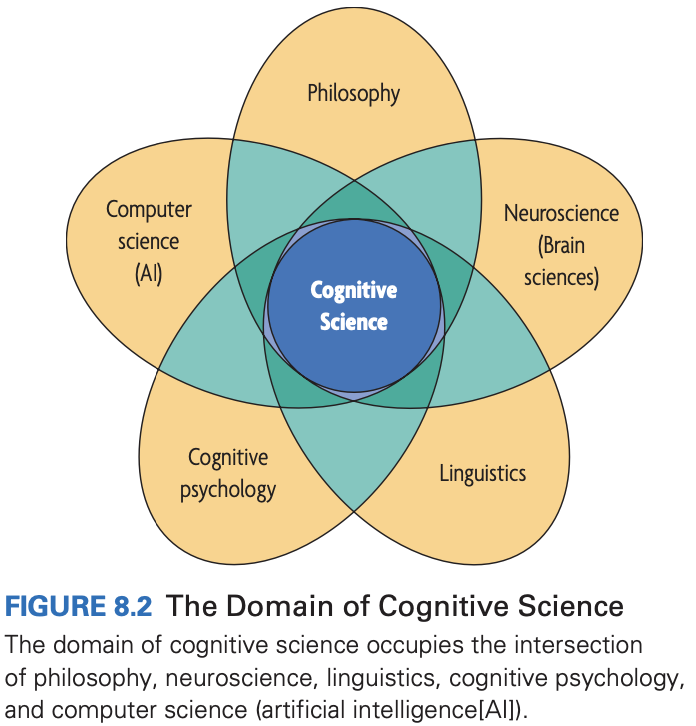
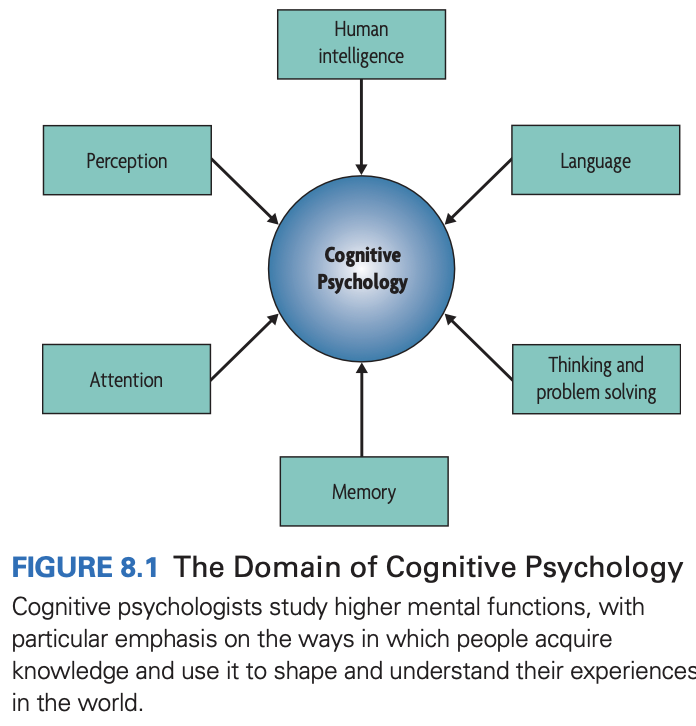
7.2. Language Research
Language: A system of symbols and rules that enable us to communicate. Our spoken, written, or signed words and the ways we combine them as we think and communicate.
- Function: communicate, express emotion, social interaction, record fact.
- Structure: Phonemes, morphemes, grammar.
Language comprehension: Involves a complex string of processes: phoneme- meaning.
- Research questions:
- Comprehension strategies and timing
- How to resolve lexical ambiguity? E.g., bank
- Are metaphors, e.g., time is money, understood directly?
- Which areas of the brain are activated during reading?
- How does word imagery affect comprehension?
8. Chapter 11: Motivation
8.1. Maslow’s Hierarchy of Needs
A. Maslow
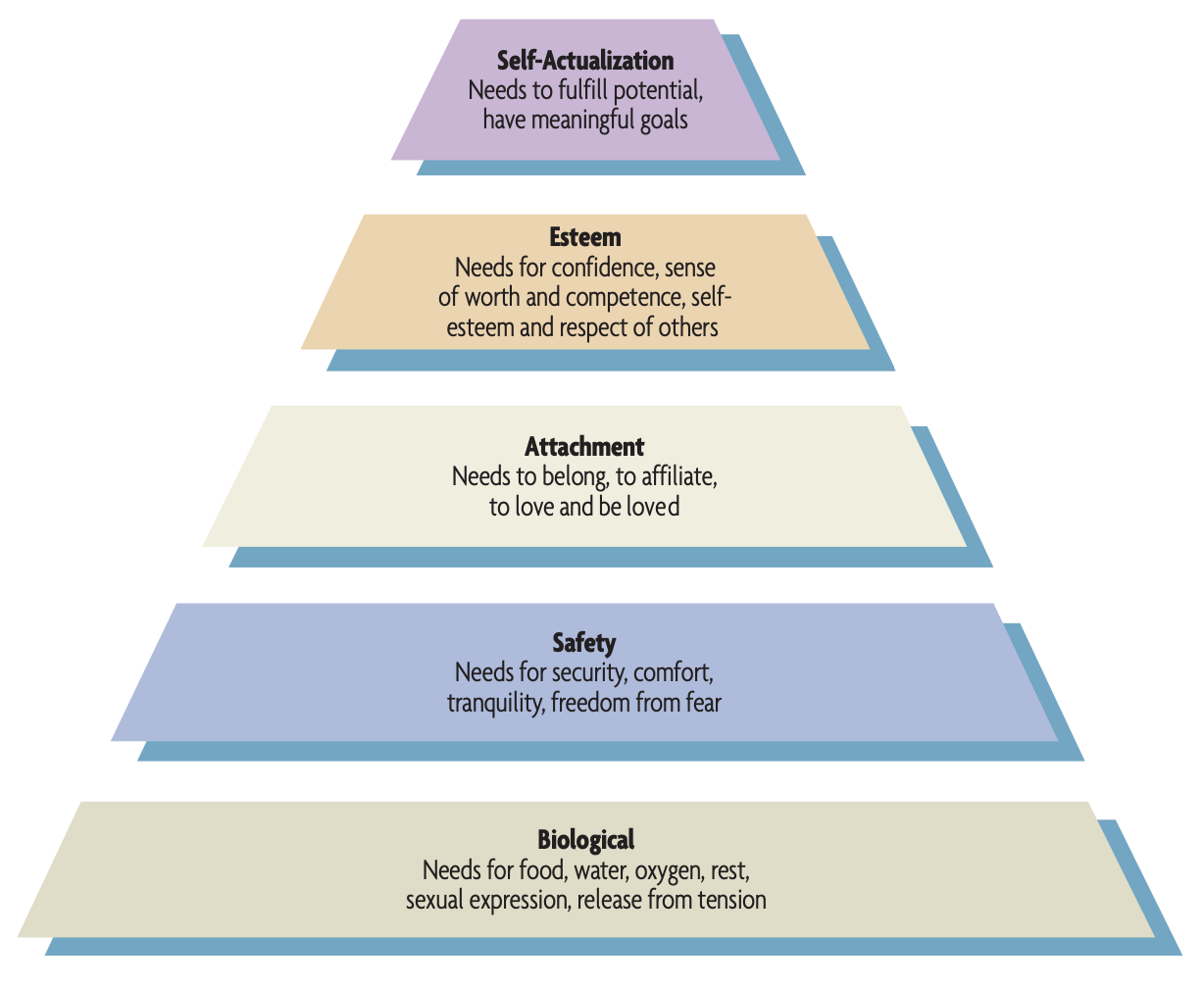
- the needs at each level of the hierarchy must be satisfied before the next level can be achieved
- The satisfactions of the higher needs require a better conditions
- the lower needs are stronger than the higher needs and develop earlier than the higher ones
- A self-actualizing person is self-aware, self-accepting, socially responsive, creative, spontaneous, and open to novelty and challenge, among other positive attributes
9. Intelligence and Intelligence Assessment
9.1. Definition of Assessment
Basic features of formal assessment:
- Reliability
- This refers to the consistency of scores obtained from an assessment. A reliable assessment instrument yields consistent results when used multiple times on the* same individuals or groups*.
- Validity
- how well it measures what it is intended to measure. A valid assessment accurately captures the specific trait or characteristic it aims to assess.
- Norms
- Norms offer a frame of reference for interpreting test scores. They provide information about how individuals’ scores compare to the scores of a relevant reference group. (e.g., what does IQ 100 mean?)
- Standardization
- Formal assessments follow a standardized procedure, ensuring that the testing instrument is administered uniformly to all individuals under the same conditions. This approach enhances fairness and comparability of results.
9.2. Intelligence Assessment
The normal distribution of IQ scores in the general population: \(\pm \) 1 SD, \(\pm \) 2 SD
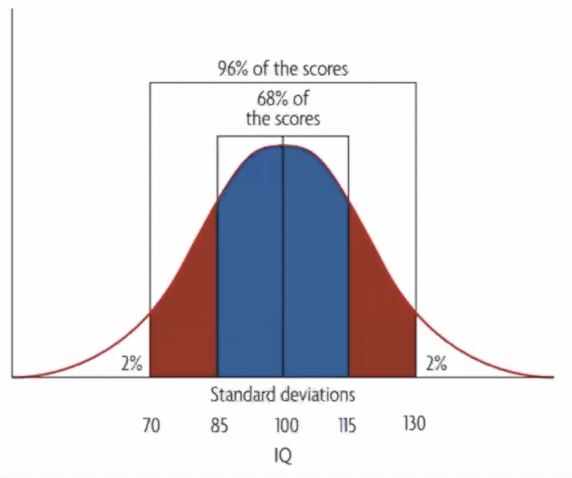
- Intelligece
- The global capacity to profit from experience and to go beyond given information about the environment. More specifically, a very general mental capability that, among other things, involves the ability to reason, plan, solve problems, think abstractly, comprehend complex ideas, learn quickly and learn from experience.
9.2.1. IQ test
The origins of intelligence testing:
- Binet’s intelligence test: to classify and seperate developmentally disabled from normal school children
The Stanford-Binet intelligence scale:
Intelligence quotient (IQ) = mental age / chronological age * 100.
The Wechsler intelligence scale: combine verbal with nonverbal subtests, Wechsler adult intelligence scale (WAIS)-IV (2008),
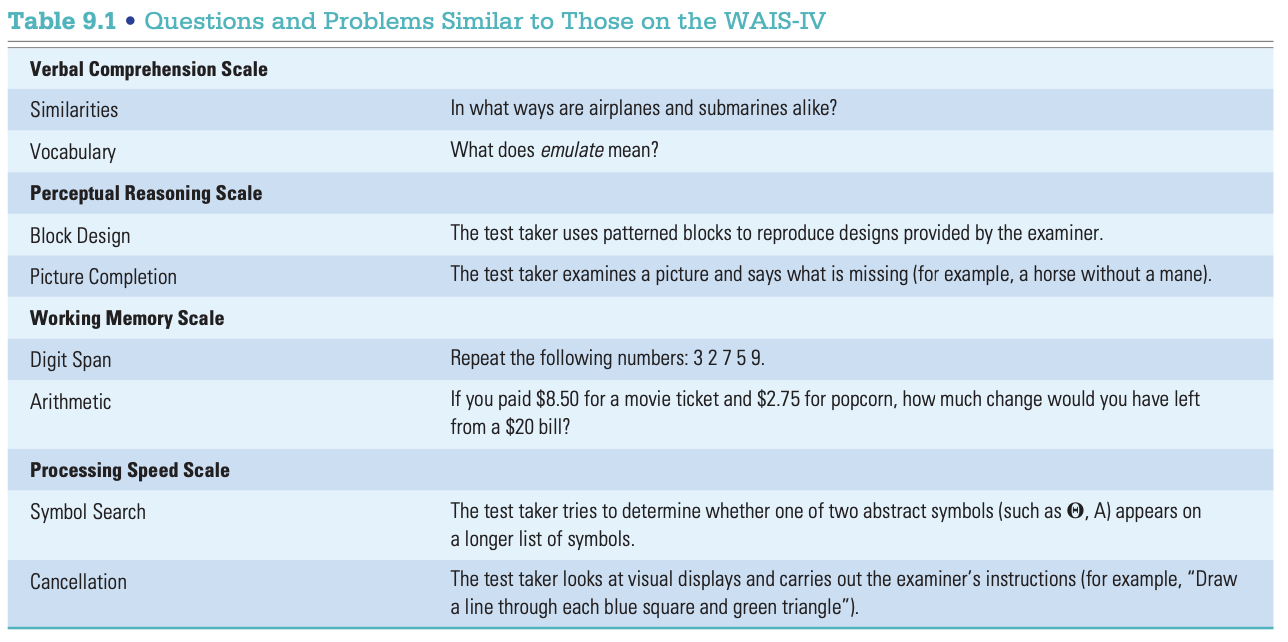
- The family of Wechsler’s IQ tests: Wechsler intelligence scale for children (ages 6 to 16, WISC-IV), Wechsler Preschool and primary scale of intelligence (ages 2.5 to 7.25, WPPSI-IV).
9.2.2. Extremes of Intelligence
- Intellectual disability (satisfy both)
- below the age of 18, IQ scores 2 standard deviations below the mean on an intelligence test.
- limitations in adaptive behavior, such as conceptual skills (language use, reading and writing, money concepts), social skills (follow rules/laws, social responsibility, avoid dvcictimization), and practical skills (personal care, health care, occupational skills)
- Giftedness
- IQ scores above 2 standard deviations.
- “Three-ring” conception: gifted individuals are found at the intersection of above-average ability, high levels of creativity, and high levels of task commitment.
Gifted individuals are better in addressing their social and emotional issues, and may have lower levels of anxiety.
9.3. Theories of Intelligence
9.3.1. Cattell
Crystallized intelligence and fluid intelligence:
- Crystallized intelligence
- involves the knowledge a person has already acquired and the ability to access that knowledge. It is measured by tests of vocabulary, arthmetic, and general information.
- Fluid intelligence
- is the ability to see complex relationships and solve problems. It is measured by tests of block designs and spatial visualization in which the background information needed to solve a problem is included or readil apparent.
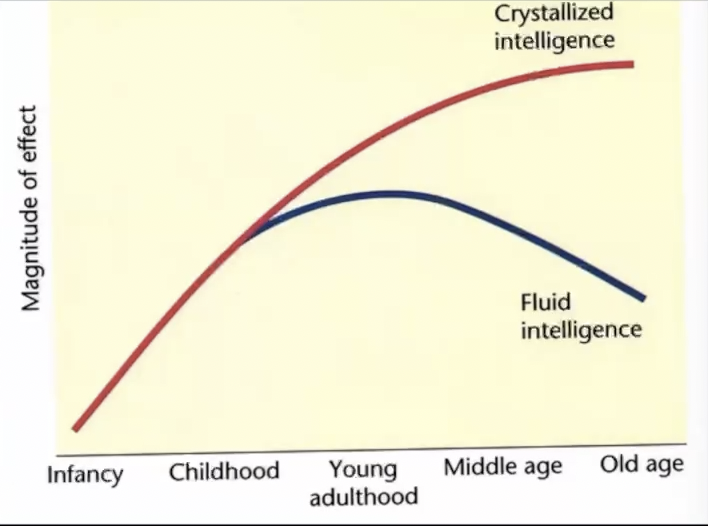
9.3.2. Spearman’s general intelligence and specific skills
- General intelligence (g): The performance of individuals on each of a variety of intelligence tests was highly correlated - a general intelligence underlying all intelligent performance.
- Specific skills (s): Each individual domain also has associated with it specific skills.
- A person’s performance on a test depends both on the person’s g and s.
9.3.3. Sternberg’s 3 intelligences
- Analytical intelligence: information processing (like academic problem-solving)
- Creative intelligence: the ability to deal with novel problems
- Practical intelligence: involves your ability to adapt to new and different environments, select appropriate environments, and effectively shape your environment to suit your needs.
9.3.4. Gardner’s multiple intelligences
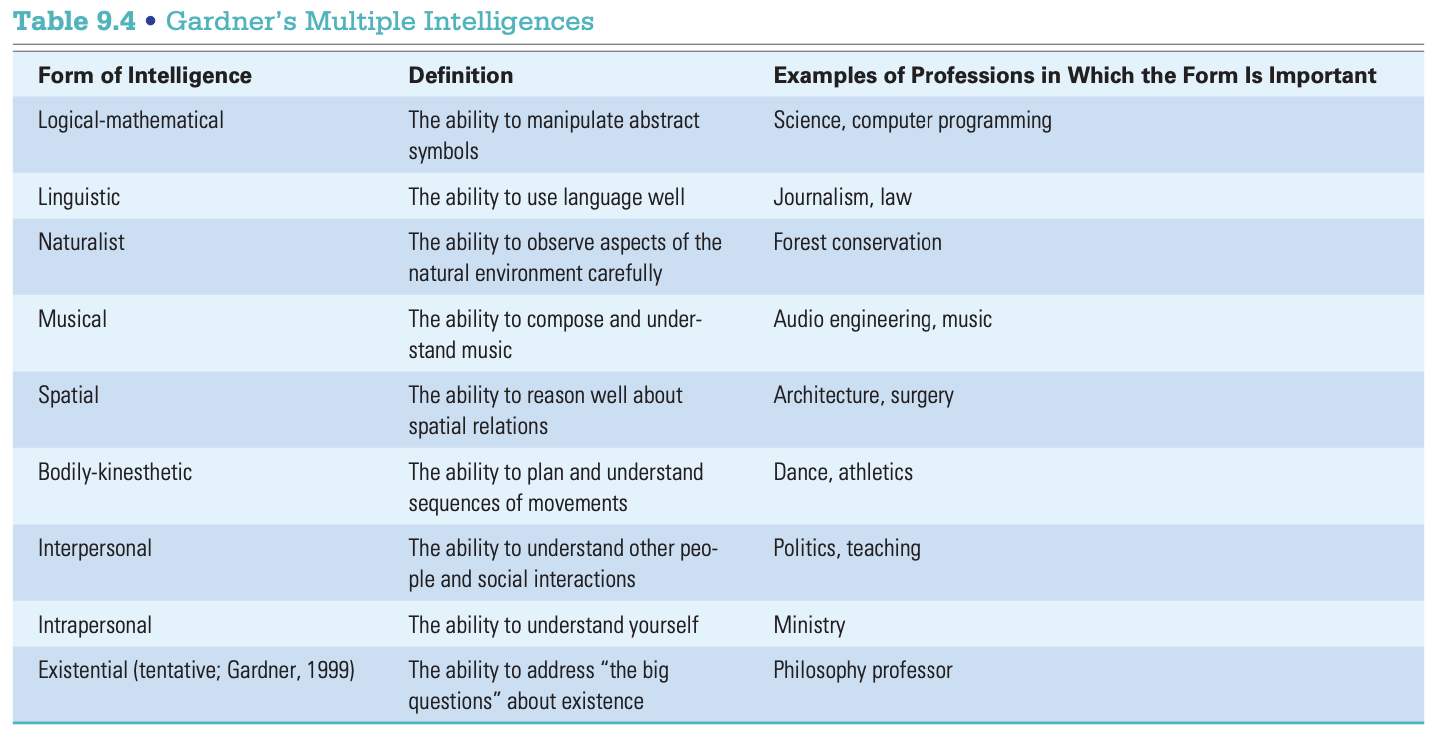
Implication: People can excel in domains that are not recognized by traditional conceptions of intelligence.
Critics: Overlap among people’s functioning on what Gardner argues are separate types of intelligence
9.3.5. Emotional Intelligence
- Emotional Intelligence
- The ability to perceive, appraise, and express emotions accurately and appropriately.
- The ability to use emotions to facilitate thinking
- The ability to understand and analyze emotions and to use emotional knowledge effectively.
- The ability to regulate one’s emotions to promote both emotional and intellectual growth
Test: Multifactor emotional intelligence scale, MEIS.
9.3.6. Heredity and IQ
To assess the extent to which intelligence is genetically deterimined.
- need to tease apart the effects of shared genes and shared environment.
- Genetic influence
- identical twins show higher correlations between their IQs than fraternal twins or other sibling pairs do
- Environmental influence
- the correlations are also higher when the twins and other sibling pairs were raised together.
- Heritability estimate
- A heritability estimate of a particular trait, such as intelligence, is based on the proportion of the variability in test scores on that trait that can be traced to genetic factors.
- about 30 to 80% of the variance in IQ scores is due to genetic makeup. For hieght, 93-96%.
- Heritability estimates pertain only to the average in a given population of individuals. We cannot determine the specific generic contribution to any individual’s IQ.
9.3.7. Environments and IQ
- Socioeconomic status (SES) of the family
- Children from more privileged, high-SES backgrounds are likely to have higher IQs than their less privileged, low-SES peers.
- Poor helath, low birth weight, lowered mental ability
- Lack of books, written media, computers, and other materials.
- Poor parents have little time or energy to play with intellectually stimulate their children.
The Head Start Program: (US federal government)
- (poor-family) Children are exposed to special preschool education, they receive decent daily meals, and their parents are given advice on health and other aspects of child rearing.
9.3.8. Intelligence and Life Quality
Intelligent people have longer lives:
- Better environment
- More efficient brains
- More education, fewer potential dangers
- Engage in fewer unhealty behaviors.
10. TODO Human Development
Developmental Psychology: The area of psychology that is concerned with changes in physical and psychological functioning that occur from conception across the entire life span.
3 domains: Physical, cognitive, social-emotional.
10.1. Physical Development
10.1.1. Prenatal and Childhood Development
- Germinal stage (胚种期): first 2 weeks after formation of the zygote
- Embryonic stage (胚胎期): 3-8 weeks
- Fetal stage (胎儿期): 9 weeks to the birth
10.1.2. Babies Prewired for Survival
Reflex: a response that is naturally triggered by specific stimuli that are biologically relevant for the organism.
- Rooting reflex
- when something brushes against infants’ cheeks, they turn their heads in that direction.
- Sucking reflex
- when an object is placed in their mouths, infants begin to suck.
Hearing: Capable of hearing, but auditory acuity not completely mature. By week 3, recognize mom’s voice.
Seeing: Visual acuity not fully developed but can see to some extent.
Touch, smell, and taste: Not onlt present at birth, but are reasonably sophisticated. Can discrimiate different tastes.
10.1.3. Growth and Maturation in Childhood
Physical growth is accompanied by the maturation of motor ability
- Sensitive period (Weak critical period)
- an optimal stage for children to have appropriate environmental experiences relevant to normal development, i.e., otherwise, they will experience development with more difficulty, but still doable.
- Development will proceed most smoothly if children have those experiences during the sensitive period.
- (Strong) critical period
- a maturational stage during which children must obtain appropriate environmental experiences, i.e., otherwise, they may not be able to develop a particular function. The condition is a stronger.
Principles:
- Cephalocaudal: from head to foot.
- Proximodistal: from center to the extremities.
- From gross o fine motor skills (which require more precise coordination of smaller muscles).
Gesell’s Maturational Theory, the Ladder experiment
- Subjects: a pair of identical twins A and B
- At 46 weeks, A started to climb the ladder for 10 minutes every day,
and B did not.
- After 6 weeks, how long would it take A and B to climb 5 steps?
- How about when they turned one-year old?
10.2. Cognitive Development
the study of the processes and products of the mind as they emerge and change over time.
10.2.1. Piaget’s Theory
Method: interviews and experiments with his 3 children
Basic concepts:
- Scheme 图式
- the mental structures for selecting information and interpreting the world
- Assimilation 同化
- new environmental information is modified (digested) to fit into what is already known
- Accommodation 顺应
- existing schemes are restructured or modified to understand and interpret new information
The interweaving of assimilation and accommodation results in new cognitive development & adaptation
| Stages | Age | Schemes | Achievement/Limitation |
| Sensorimotor | 0-2 | Use body movement to coordinate sensations. Sensorimotor sequences,such as looking at mother when she speaks | From “out of sight, outof mind ” to object permanence (representation of “absent object”) |
| Preoperational | 2-7 | Improved ability to represent mentally objects that are not physically present; language/images/gestures | Egocentrism: inability to take the perspective of another person. Centration: Fail to use mental operation |
| Concrete operations | 7-11 | Reasoning with respect to concrete physical objects; concepts/categories/perspective taking | Conservation / reversibility |
| Formal operations | 11+ | Abstract reasoning and hypothetical thinking; applied to both concrete and abstract (hypothetical & future) situations | “Scientist” thinking / topics like truth, justice and exercise |
- Sensorimotor stage: Object permanence refers to children’s understanding that objects exist and behave independently of their actions or awareness.
- Preoperational stage:
- Egocentrism (自我中心)
- The child’s inability to take the perspective of another person.
- Centration (中心化)
- focus their attention on only one aspect of a situation and disregard other relevant aspects.
- Concrete operational stage:
- Conservation
- know that the physical properties of objects do not change when nothing is added or taken away, even though the objects’ appearances change.
Limitations:
- Underestimate an infant’s capacity while overestimate adolescents’; neglect the role of culture and education
- Development is a more continuous course
- Post-formal operations: beyond Piaget’s formal operations, considering practical experience, moral judgment and values.
10.2.2. Cognitive Development in Adulthood
- Intelligence: fluid intelligence (learn quickly and thoroughly), crystallized intelligence (verbal abilities). Age-related gains in wisdom - expertise in the fundamental practices of life (Staudinger & Glück, 2011)
- Memory: aging does not affect the access to the information stored long ago; instead, aging affects the processes that allow new information to be effectively organized, stored, and retrieved (Buchler & Reder,2007).
10.3. Social-emotional Development
10.3.1. Erikson’s psychosocial stages
Erik Erikson: trained by Sigmund Freud’s daughter, Anna Freud.
- Proposed that every individual must successfully navigate a series of psychosocial stages, each of which presented a particular conflict or crisis.
- How to solve crisis:
- The interaction between dispositions and supports from the social environment.
- The quality of the social interactions matters.
| Age | Crisis | Adequate resolution | Critical social experiences |
| 0-1 | Trust vs. mistrust | Developing a sense that the world is safe and good | A caring and consistent mother |
| 1-3 | Autonomy vs. self-doubt | Realizing that one is an independent person with the ability to make decisions | Patient and supportive (vs. excessive restriction or criticism) |
| 3-6 | Initiative vs. guilt | Developing a willingness to try new things and to handle failure | Encourage the sense of freedom and self-confidence |
| 6-11 | Competence vs. inferiority | Learning competence in basic skills and to cooperate with others | Encouraging parents and trustful peers & teachers |
| 11-20 | Identity vs. role confusion | Developing a coherent, integrated sense of inner self | Supportive social surroundings |
| 20-40 | Intimacy vs. isolation | Establishing ties to another in a trusting, loving relationship | Partners whom you can identify with |
| 40-65 | Generativity vs. stagnation | Finding meaning in career, family, and community via productive work | Satisfying career and family life |
| 65+ | Ego integrity vs. despair | Viewing one’s life as satisfactory and worth living | Supporting younger |
10.3.2. Social Development in Childhood
Temperament (气质) - biologically based levels of emotional and behavioral response to the environment.
4 kinds of temperaments (Thomas & Chess, 1984)
- easy babies (40%): have a positive disposition; their body functions operate regularly and they are adaptable.
- difficult babies (10%): have negative moods and are slow to adapt to new situations; when confronted with a new situation, they tend to withdraw.
- slow-to-warm-up babies (15%): are inactive, showing relatively calm reactions to their environment; their moods are generally negative, and they withdraw from new situations, adapting slowly.
- The remaining 35 % cannot be consistently categorized
10.3.3. Attachment
Attachment (依恋) – a close emotional relationship between infants and caregiver, providing the basis of survival and socialization/cognitive development
Secure base
- Infant will seek his/her caregiver when facing threat and danger
- Caregiver provides the sense of safety and structure that allow the infant to explore the world and grow
Assessment of the attachment style: The Strange Situation Test (Ainsworth & colleagues, 1978)
- The child is brought into an unfamiliar room filled with toys. With the mother present, the child is encouraged to explore the room and to play. After several minutes, a stranger comes in, talks to the mother, and approaches the child. Next, the mother exits the room. After this brief separation, the mother returns, there is a reunion with her child, and the stranger leaves.
- Key point for assessment: How child react after the mother leaves & returns
- Securely attached children (65%) show some distress when the parent leaves the room; seek proximity, comfort, and contact upon reunion; and then gradually return to play.
- Insecurely attached–avoidant children (20%) seem aloof and may actively avoid and ignore the parent upon her return.
- Insecurely attached–anxious/ambivalent children (15%) become quite upset and anxious when the parent leaves; at reunion, they cannot be comforted, and they show anger and resistance to the parent but, at the same time, express a desire for contact.
- High correlation of attachment styles has been observed, e.g. Infant & children (Bohlin et.al., 2000)
Parenting Styles:

- Demandingness
- the extent to which parents expect their children to behave.
- Responsiveness
- the extent to which parents are sensitive to their children’s needs.
11. Human Personality
- Personality
- The complex set of psychological qualities that influence an individual’s characteristic patterns of behavior across different situations and over time.
11.1. Trait Personality
- Trait
- enduring quality or attribute that predisposes individuals to behave consistently across situations
Allport’s trait approach: three kinds of traits
- Cardinal traits: traits around which a person organizes his or her life.
- Central traits: traits that represent major characteristics of a person, e.g., honesty, shyness.
- Secondary traits: specific personal features that help predict an individual’s behavior but are less useful for understanding an individual’s personality. E.g., food preferences.
Allport saw personality structures, rather than environmental conditions, as the critical determiners of individual behavior.
11.1.1. Five-factor model

11.2. Psychodynamic
11.2.1. Psychosexual development
Sigmund freud:
- Psychic energy – the source of motivation for human actions
- Two basic drives: self-preservation (meeting such needs as hunger and thirst) & Eros, the driving force related to sexual urges and preservation of the species.
- Libido: the psychic energy that drives individuals toward sensual pleasures of all types, especially sexual ones.
- Erogenous zones: genitals and other sensitive areas
Five stages:
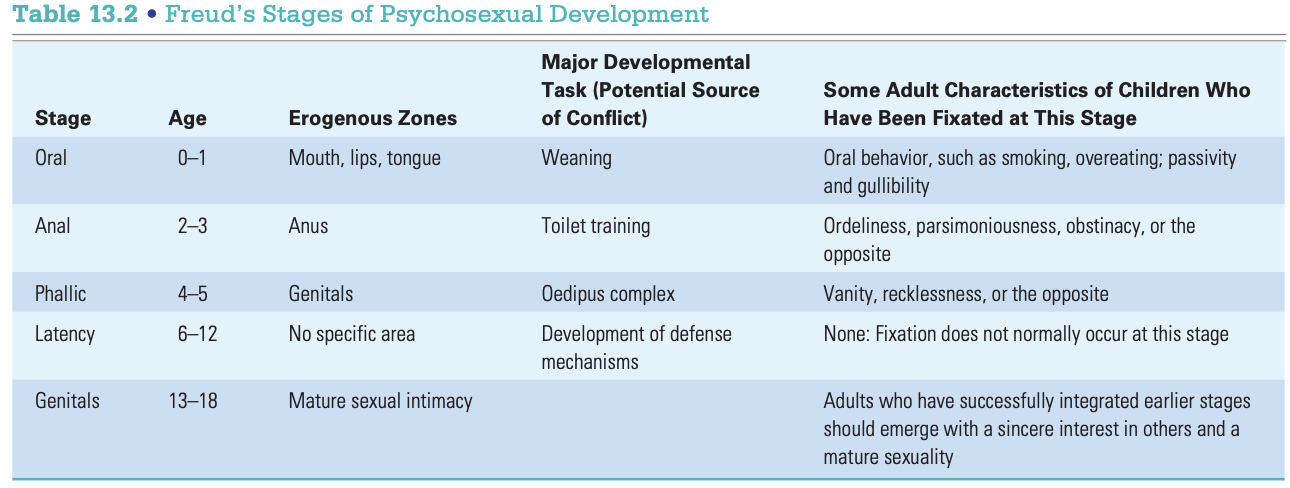
Key concepts:
- Fixation : an inability to progress normally to the next stage of development, which is due to too much gratification or too much frustration at one of the early stages.
- Psychic determinism: the assumption that all mental and behaviorall reactions are determined by earlier experiences.
- Unconscious: the repository of information that is unavailable to conscious awareness: Freud’s most important contribution to the science of psychology.
- Unconscious thinking or information could be reflected by neurotic symptoms, dreams, and slips of the pen and tongue.
- Freudian slip: verbal or memory mistake that is linked to the unconscious mind.
- Free association:the principal procedure used in psychoanalysis to probe the unconscious and release repressed material.
The structure of personality:
- The id is the storehouse of the fundamental drives. It operates irrationally, and is governed by the pleasure principle, without concern for consequences. The id wants to do what feels good
- The superego, the conscience(良心), is the storehouse of an individual’s values, including moral attitudes learned from society. It is the inner voice of oughts and should nots. Superego insists on doing what is right.
- The ego is the reality-based aspect of the self that arbitrates the conflict between id impulses and superego demands.
Ego defense:
- Ego defense mechanism are mental strategies the ego uses to defend itself in the daily conflict between id impulses that seek expression and the superego’s demand to deny them - Vital to an individual’s psychological coping with powerful inner conflicts.
- Repression – keeps information out of consciousness, basic defense
- Anxiety is an intense emotional response triggered when a repressed conflict is about to emerge into consciousness. Repression is not working!
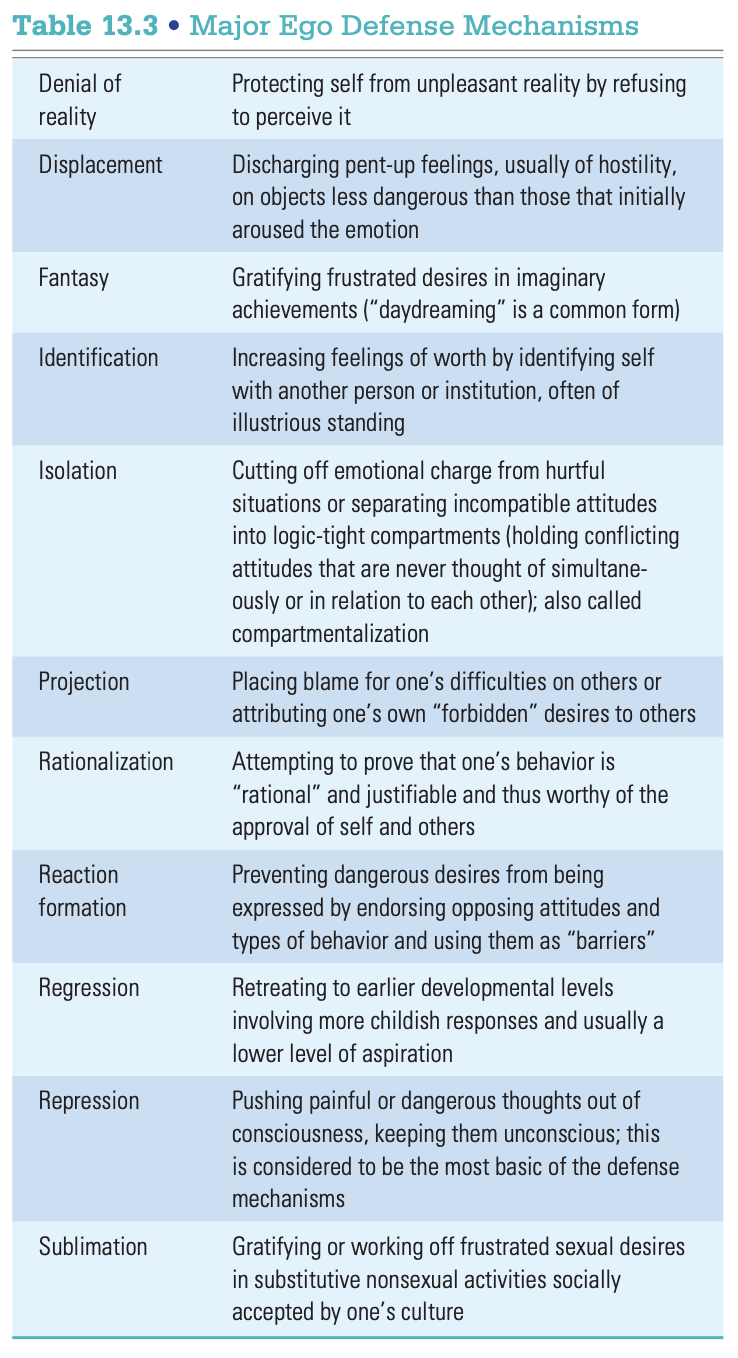
11.3. Humanistic
- Self is a central concept for personality.
- Self-actualization (A. Maslow) is a constant striving to realize one’s inherent potential: move each person toward generally positive behaviors and enhancement of the self.
- Unconditional positive regard
- children should feel they will always be loved and approved of, in spite of their mistakes and misbehavior.
- Adult: you need to give to and receive unconditional positive regard from those to whom you are close & you need to feel unconditional positive self- regard, in spite of the weaknesses you might be trying to change.
Features:
- Favorable environmental circumstances – an atmosphere of warmth, the goodwill of others, and parental lover of the child as a “particular individual”
- needs
- Unconditional positive regard
- Genuineness – sincerely express inner feeling, no disguise
- Empathy – understand others’ feelings
Nonviolent Communication, by Marshall Rosenbberg
- If “violent” means acting in ways that result in hurt or harm, then much of how we communicate—judging others, bullying, having racial bias, blaming, finger pointing, discriminating, speaking without listening, criticizing others or ourselves, name-calling, reacting when angry, using political rhetoric, being defensive or judging who’s “good/bad” or what’s “right/wrong” with people—could indeed be called “violent communication.”
12. Mental Disorder
Mental disorder is typically based on the evaluation of behavior. 7 criteria
- Distress or disability - a man who cannot leave his home without weeping would be unable to pursue ordinary life goals.
- Maladaptiveness 适应不良: the most important.
- Irrationality
- Unpredictability
- Unconventionality and statistical rarity
- Observer discomfort
- Violation of moral and ideal standards
DSM-5 (2013): Diagnostic and Statistical Manual of Mental Disorders, by American Psychiatric Association.
- Emphasizes the description of patterns of symptoms and courses of disorders rather than etiological theories or treatment strategies.
- The purely descriptive terms allow clinicians and researchers to use a common language to describe problems while leaving room for disagreement and continued research about which theoretical models best explain the problems
12.1. Anxiety disorders
- Anxiety disorders
- Mental disorder marked by psychological arousal, feeling of tension, and intense apprehension without apparent reason
- Generalized anxiety disorder
- When a person feels anxious or worried most of the time for at least six months, when not threatened by any specific danger, clinicians diagnose generalized anxiety disorder.
- The anxiety is often focused on specific life circumstances + Suffer from at least 3 symptoms: as muscle tension, fatigue, restlessness, poor concentration, irritability, or sleep difficulties (5.7%)
Panic Disorder
- Experience unexpected, severe panic attacks that may last only minutes, like heart attack – in contrast to the chronic presence of anxiety in generalized anxiety disorder.
- A panic disorder is diagnosed when an individual has recurrent unexpected panic attacks and also begins to have persistent concerns about the possibility of having more attacks. (4.7%)
Phobias: 恐惧症
- A person with a phobia suffers from a persistent and irrational fear of a specific object, activity, or situation that is excessive and unreasonable given the reality of the threat.
- Social phobia – irrational fear in anticipation of a public situation (12.1)
- Specific phobia – animal type (cats, dogs, snakes, spiders); natural environment type(storms, heights); blood-injection-injury type (blood, needles) ; situational type (closed spaces, railways)
Obsessive-Compulsive Disorder (OCD) 强迫症
- Obsessions
- are thoughts, images, or impulses that recur or persist despite a person’s efforts to suppress them.
- Compulsions
- are repetitive, purposeful acts performed according to certain rules in response to an obsession - either unreasonable or clearly excessive.
Posttraumatic stress disorder (PTSD)
- An anxiety disorder that is characterized by the persistent reexperience of those traumatic events through distressing recollections, dreams, hallucinations, or flashbacks.
- Individuals may develop PTSD in response to rape, life-threatening events or severe injury, and natural disasters.
- About 15 percent of individuals who were evacuated from the World Trade Center on September 11, 2001, met diagnostic criteria for PTSD two to three years after the terrorist attack (DiGrande et al., 2011)
12.2. Mood disorders
- Mood disorders
- A mood disturbance such as severe depression or depression alternating with mania (狂躁)
Major depressive disorder:
- A mood disorder characterized by intense feelings of depression over an extended time, without the manic high phase of bipolar depression. (16%)
- People diagnosed with depression differ in terms of the severity and duration of their symptoms, from weeks to years.
- Accounts for the majority of all mental hospital adimssions.
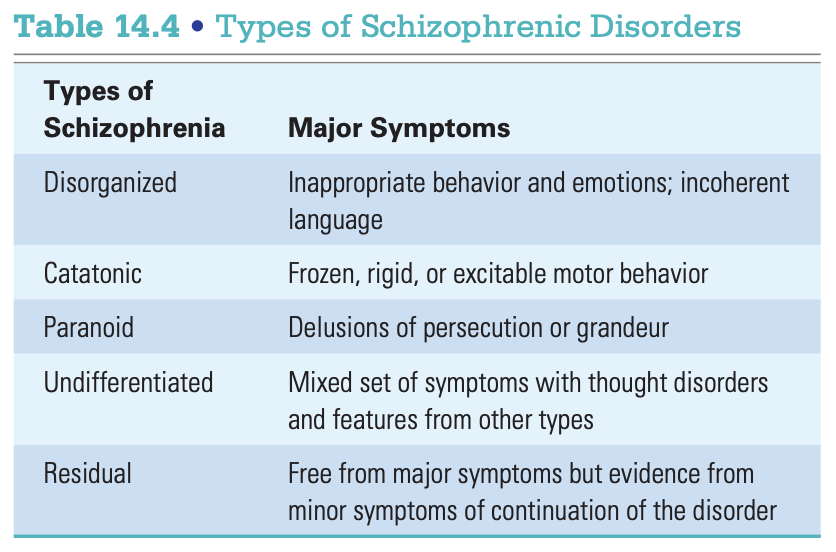
Bipolar disorder
- is characterized by periods of severe depression alternating with manic episodes (3.9%).
- A person experiencing a manic episode generally acts and feels unusually elated and expansive, or irritated.
- When in a manic mood, the person shows unwarranted optimism, takes unnecessary risks, promises anything, and may give everything away
- Walt Whitman, Ernest Miller Hemingway
12.3. Disorders of Childhood
Attention-Deficit Hyperactivity Disorder (ADHD):
- Refers to two clusters of symptoms:
- Inattention that is not consistent with their level of development. - children must show signs of hyperactivity-impulsivity 过度冲动 that, is not consistent with their developmental level.
- Last for at least six months before age 7.
- 9% (age 5-17), 12.3% for boys and 5.5% for girsl
Autistic Disorder 自闭症
- A developmental disorder characterized by severe disruption of children’s ability to form social bonds and use language.
- also engage in repetitive and ritualistic behaviors: They might, for example, place objects in lines or symmetrical patterns.
- Difficult to establish social relationships.
